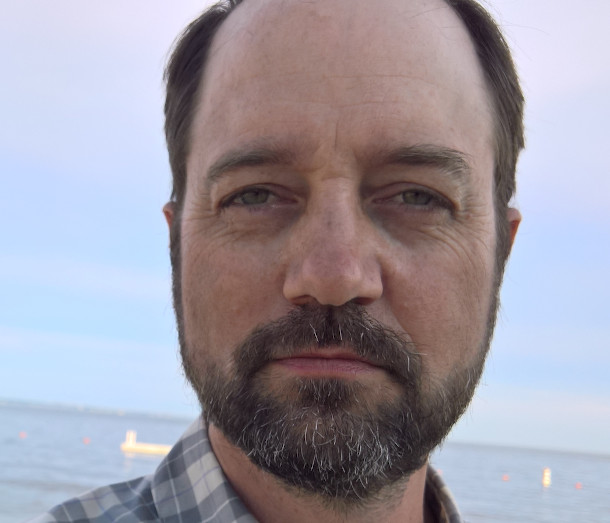Ice Visions
Air Date: Week of January 21, 2022
A “classic” version of Hoffner’s Ice Visions, photographs of ice-fishing holes as they re-freeze. (Photo: Courtesy of Erik Hoffner)
As winter settles in over the northern hemisphere people find creative ways to get outside and enjoy nature. For environmental journalist and photographer Erik Hoffner, winter is a time for ice skating, a passion which gave rise to some unusual art, now 20 years in the making.
Transcript
CURWOOD: As winter settles in over the northern hemisphere people find creative ways to get outside and enjoy nature. For environmental journalist and photographer Erik Hoffner winter is a time for ice skating, a passion which gave rise to some unusual art.
HOFFNER: The first house I rented after moving to New England two decades ago was on a lake. I love ice skating, and felt lucky when a cold, dry December created a perfect scenario for skating just outside my door.
[ICE SKATING SOUNDS]
HOFFNER: Most mornings I’d pull on skates and glide across that lake until my legs were shaky and sore. The hiss and scrape of blades on ice was often the only sound against the deep, cold quiet of the sleeping landscape. The ice that first year was so clear I could watch fish swimming below. In early winter as the ice formed I could even hear its cracks, and groans, and pings through the floor of my house.
A “climate-changed” version of Hoffner’s Ice Visions. (Photo: Courtesy of Erik Hoffner)
[GROANS & PINGS OF ICE]
HOFFNER: Then ice fishermen drilled perfectly round holes in the lake. And overnight tiny bubbles filtering up from sediments below were caught in thickening water inside the holes while inches of new ice formed. The bubbles stretched as the water refroze, creating streaks that radiated from the center outward much like the lines that radiate out in the iris of an eye. These holes seemed to become the lake’s own eyes, gazing at and reflecting the starry night sky. The formations were all different, like snowflakes. In the morning light, they just could look like stars, cells, or galaxies. Now every year in early winter I strap on my skates in a kind of treasure hunt for the holes and shoot black and white photos of them. Over 20 years I built up a huge collection of these Ice Visions. I don’t know what’s more fun, taking the pictures or pulling on my skates to fly over the frozen water on those quiet winter mornings. Some years, though, it snows early, before the ice reaches a safe thickness, making skating impossible. And the photos I take on this choppy, gray canvas are less captivating than when refrozen holes are framed by that smooth, black ice which resembles deep space. Last winter started cold, and good, safe ice set early, but then the weather warmed for a long stretch well into January and what I saw inside the fishing holes surprised me.

Erik Hoffner is a writer and photographer. (Photo Courtesy of Erik Hoffner)
Instead of building 2 or 3 inches of new ice in each hole overnight, there was often just a skin at the surface, so thin you could poke a finger through it. And the tiny bubbles trapped beneath that thin layer of ice pooled with others to create large, semi-frozen bubbles that oozed and flowed together. They looked entirely different, not so much like eyes or stars but rather distorted faces, and strange animals. It was like seeing the face of climate change. It’s too soon to say whether it will be too warm again this year. But there’s already safe ice on lakes in my town, so I’ve taken the cameras and skates out several times and look forward to discovering what wonders this winter will bring.
[ICE SKATING SOUNDS]
CURWOOD: That’s journalist and photographer Eric Hoffner. His work was recently acquired for the permanent collection of the Bates Museum of Art in Maine. For links to his photographs visit the Living on Earth website loe.org.
Links
Brattleboro Museum and Art Center | Erik Hoffner: Ice Visions
Living on Earth wants to hear from you!
Living on Earth
62 Calef Highway, Suite 212
Lee, NH 03861
Telephone: 617-287-4121
E-mail: comments@loe.org
Newsletter [Click here]
Donate to Living on Earth!
Living on Earth is an independent media program and relies entirely on contributions from listeners and institutions supporting public service. Please donate now to preserve an independent environmental voice.
NewsletterLiving on Earth offers a weekly delivery of the show's rundown to your mailbox. Sign up for our newsletter today!
 Sailors For The Sea: Be the change you want to sea.
Sailors For The Sea: Be the change you want to sea.
 The Grantham Foundation for the Protection of the Environment: Committed to protecting and improving the health of the global environment.
The Grantham Foundation for the Protection of the Environment: Committed to protecting and improving the health of the global environment.
 Contribute to Living on Earth and receive, as our gift to you, an archival print of one of Mark Seth Lender's extraordinary wildlife photographs. Follow the link to see Mark's current collection of photographs.
Contribute to Living on Earth and receive, as our gift to you, an archival print of one of Mark Seth Lender's extraordinary wildlife photographs. Follow the link to see Mark's current collection of photographs.
 Buy a signed copy of Mark Seth Lender's book Smeagull the Seagull & support Living on Earth
Buy a signed copy of Mark Seth Lender's book Smeagull the Seagull & support Living on Earth

